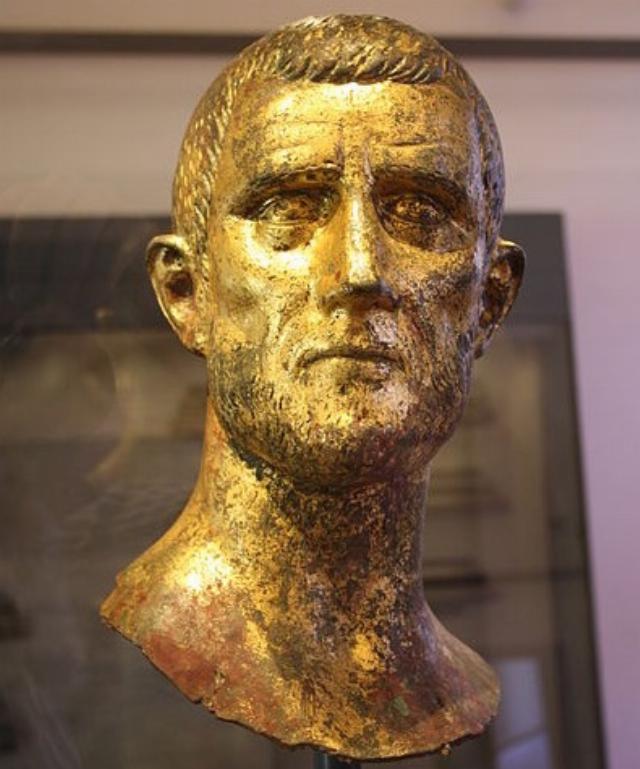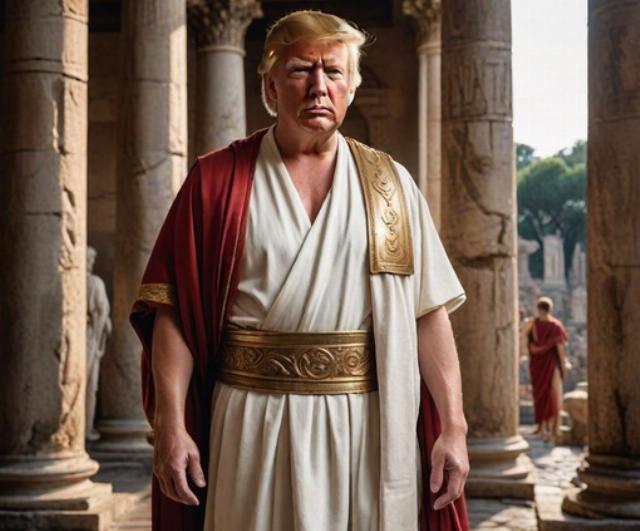We support our Publishers and Content Creators. You can view this story on their website by CLICKING HERE.
Sometimes history is history, sometimes it’s a harbinger, and sometimes it’s current events. The story of the Roman Emperor Aurelian is all three…
Aurelian took power in 270 AD. The previous 35 years had been nothing short of a disaster for the Empire on multiple fronts.
The trouble began with Commodus’s (well-deserved) assassination in 192 AD. After that, the army, always a force to be reckoned with, required ever-increasing bribes to remain loyal. Not surprisingly, the power of the army increased accordingly.
At the same time, the treasury continued its centuries-long practice of reducing the amounts of silver and gold in Roman coins, creating a ticking timebomb of inflation.

Image: Emperor Aurelian (cropped). Photo by Giovanni Dall’Orto.
What is known as the Crisis of the Third Century began in earnest in 235 AD with Severus Alexander’s assassination. At that point, the Roman map was about what it had been like when Augustus died in 14 AD, which included basically everything surrounding the Mediterranean. Just 35 years later, when Aurelian took over, the crisis hit its nadir, and the Empire was a much smaller, fractured disaster, with repeated foreign invasions, civil wars, and economic collapse.
Born in modern-day Serbia, Roman citizen Aurelian joined the Army at 20. In short order, he would prove his mettle as a brilliant cavalry commander and, over his 35-year-long career, would command increasing numbers of men, eventually encompassing the entire army under Emperor Claudius II.
Upon Claudius’s death, Aurelian’s troops proclaimed the 55-year-old Aurelian Emperor. After a short battle with Quintillus, the Senate’s choice, Aurelian prevailed and took control of the Empire.
The empire he inherited was a far cry from the one Augustus had left. By 270, a huge swath of the Western empire, encompassing today’s France, Netherlands, Belgium, and parts of Germany and the UK, had basically been carved off into a rival, the Gallic Empire. In the eastern end of the Mediterranean, a crescent of land stretching from Egypt, then the most valuable province in the Empire, to what is today’s Turkey had become the Palmyrene Empire, run by one of antiquity’s most powerful women, Queen Zenobia. Making matters worse, in addition to the empire being fractured, what was left was regularly under siege from barbarians on all sides.
This is the empire Aurelian found himself leading. He began his reign by expelling various barbarian tribes from northern Italy. Next, he went to the Balkans and crushed the Goths. But there is no rest for the weary.
Over in the formerly Roman-aligned Palmyra, now the Palmyrene Empire, Queen Zenobia (acting as regent for her son, Vaballathus) sought to convince the Romans to recognize Palmyrene independence. To demonstrate her power, she withheld the Egyptian grain supply in 272. The result was not the one she had hoped for. Aurelian made his way east and easily defeated her. The next year, he would take back Egypt. During the fighting, the great Library of Alexandria burned, destroying the greatest collection of works from the ancient era.
With the east in order, Aurelian headed west to crush the so-called Gallic Empire and bring it back into the Roman fold. Unlike the East, however, Aurelian brought the West back with relatively little bloodshed. He secretly negotiated with the “Gallic Emperor” Tetricus to defect to his side in return for a senatorship. Although a battle ensued, it was short-lived as no one involved was interested in fighting a battle when both leaders were on the same side.
By 274, Aurelian had reunified the Empire and implemented policies to fix two of the most important domestic issues: The corruption at the Mint of Rome (and others) and the grain dole system. Mike Duncan, the host of the extraordinary History of Rome podcast, calls Aurelian the Sandy Kofax of the Roman Empire. He wasn’t the longest-reigning emperor, but he was the most dominant while he was there. For the five years Aurelian ruled, he was virtually unstoppable.
But as a man, he was stoppable. In one of the great ironies in world history, in 275, the officers of his Praetorian Guard assassinated him. Even though the Guard’s raison d’être was to protect the emperor, this murder wasn’t particularly unusual. However, in Aurelian’s case, it resulted from a lie.
Aurelian was a strict disciplinarian, and one of his secretaries worried he’d be punished for telling a minor lie. To avoid this, he forged a document claiming Aurelian was planning to execute several of his officers. Fearing for their lives, these “accused” officers killed Aurelian. They soon discovered they were victims of a ruse and killed the secretary, and very possibly met similar fates themselves.
In sum, we have an empire that’s coming apart at the seams, where government employees are corrupt and demanding that more money and power be handed to them. We have an empire where inflation is rampant, and the citizens are addicted to government giveaways. We have an empire whose borders are being breached by countless invaders. Then, a competent man steps in to take control and try to fix the problems. He begins to right the ship, and he’s killed by corrupt officials.
You may be asking yourself whether I just summed up Aurelian’s reign or if I’m describing today’s America. That’s because many of the problems of the Crisis of the Third Century in Rome mirror those in America today.
Indeed, just as the Praetorian Guard was known for auctioning off the diadem and murdering emperors, we’ve seen the FBI and the CIA conspire to destroy presidents, something they’ve been doing for at least half a century. They may even have had a hand in killing one president.
Our borders are being overrun, 30% of the government’s spending is on welfare, we’re being spent into oblivion, and not enough Americans want to join the military, so the Pentagon is turning to immigrants.
While it might not seem obvious, the story of Aurelian is actually a story of hope. Not for him, obviously, but for America because he demonstrated that an empire in decline doesn’t have to acquiesce to its own demise. A crumbling nation can be rebuilt, a listing ship can be righted, and a disappearing culture can be resurrected.

AI image courtesy of Vince Coyner.
What it takes is leadership. Troubled times require a man willing to challenge what might be called “the new normal” and who reveres the culture and civilization that made the nation great in the first place. Donald Trump is just such a man.
Corrupt officials feared Aurelian because he clearly revered the Empire, and everything he did was to bring it back to its former glory. The corrupt and power-hungry members of the Swamp hate Donald Trump because he loves America, and most of the things he did and still wants to do are an attempt to make her great again.
Because his reign lasted only five years, Aurelian rarely finds his name in the pantheon of the greatest emperors. That’s unfortunate because he almost single-handedly reversed the Roman Empire’s collapse. That empire would then survive for another two centuries after his assassination.
Donald Trump finds himself in a similar position, facing a nation in decline and in danger of collapse. Let’s hope that he can successfully and safely (both for himself and the American people) bring America back from the brink. If he does, then America may lead the world for the next two centuries as it did for the last two. That just might get him on Mount Rushmore.
Follow Vince on Twitter at ImperfectUSA, or you can visit his new website Gratitude for America.

 Conservative
Conservative  Search
Search Trending
Trending Current News
Current News 


